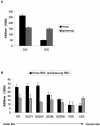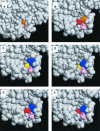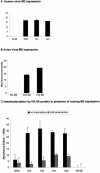Restrictions to the adaptation of influenza a virus h5 hemagglutinin to the human host
- PMID: 14671130
- PMCID: PMC303389
- DOI: 10.1128/jvi.78.1.502-507.2004
Restrictions to the adaptation of influenza a virus h5 hemagglutinin to the human host
Abstract
The binding specificities of a panel of avian influenza virus subtype H5 hemagglutinin (HA) proteins bearing mutations at key residues in the receptor binding site were investigated. The results demonstrate that two simultaneous mutations in the receptor binding site resulted in H5 HA binding in a pattern similar to that shown by human viruses. Coexpression of the ion channel protein, M2, from most avian and human strains tested protected H5 HA conformation during trafficking, indicating that no genetic barrier to the reassortment of the H5 surface antigen gene with internal genes of human viruses existed at this level.
Figures



References
-
- Bender, C., H. Hall, J. Huang, A. Klimov, N. Cox, A. Hay, V. Gregory, K. Cameron, W. Lim, and K. Subbarao. 1999. Characterization of the surface proteins of influenza A (H5N1) viruses isolated from humans in 1997-1998. Virology 254:115-123. - PubMed
-
- Claas, E. C., A. D. Osterhaus, R. van Beek, J. C. De Jong, G. F. Rimmelzwaan, D. A. Senne, S. Krauss, K. F. Shortridge, and R. G. Webster. 1998. Human influenza A H5N1 virus related to a highly pathogenic avian influenza virus. Lancet 351:472-477. - PubMed
-
- Connor, R. J., Y. Kawaoka, R. G. Webster, and J. C. Paulson. 1994. Receptor specificity in human, avian, and equine H2 and H3 influenza virus isolates. Virology 205:17-23. - PubMed
-
- Daniels, R. S., S. Jeffries, P. Yates, G. C. Schild, G. Rogers, J. C. Paulson, S. A. Wharton, A. R. Douglas, J. J. Skehel, and D. C. Wiley. 1987. The receptor binding and membrane fusion properties of influenza virus variants selected using antihaemagglutinin monoclonal antibodies. EMBO J. 6:1459-1465. - PMC - PubMed
Publication types
MeSH terms
Substances
LinkOut - more resources
Full Text Sources
Other Literature Sources

